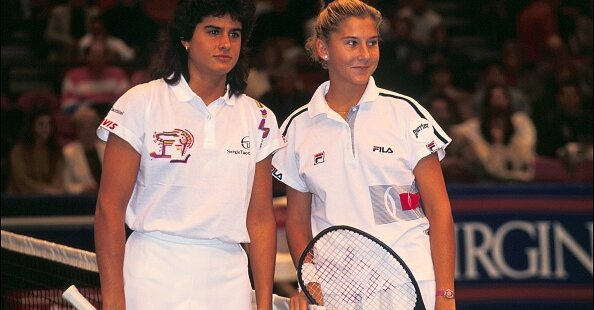Throughout their careers, Monica Seles and Gabriela Sabatini played each other 14 times, with Seles winning 11 of those matches.
But their match that stands out was the final at the season-ending Virginia Slims Championships at Madison Square Garden in New York in 1990. It was the event’s first five-set final. The change in format from two out of three sets in 1984 was the tour’s effort to help prove that the women could play as long as the men in the big tournaments and thus should receive equal prize money.
The match was a three-hour, 47-minute thriller, won by Seles 6-4, 5-7, 3-6, 6-4, 6-2. It resulted in vastly different post-match responses.
Sabatini was so exhausted after the match that when a friend visited her in the locker room her legs buckled when she tried to stand up.
Seles, however, was so energized that she went back to the hotel gym and jogged on the treadmill for an hour as she chatted with her father, Karolj.
From 1984 to 1998, the finals of the women’s year-end championships were three-out-of-five-set affairs. But that format was stopped in 1999, and the final match for the title has returned to two out of three sets since.
This year’s WTA Finals begin Saturday at the King Saud University Indoor Arena in Riyadh, Saudi Arabia, with Aryna Sabalenka, Iga Swiatek, Coco Gauff, Amanda Anisimova, Jessica Pegula, Madison Keys, Jasmine Paolini and Elena Rybakina competing.
Total prize money at the championship in 1990 was $3 million, but that has jumped to $15.5 million at this year’s WTA Finals. The champion, assuming she wins all three of her round-robin matches as well as the semifinals and final, will receive $5.235 million. Last year, Gauff won $4.805 million for beating Zheng Qinwen in the final.
Women’s tennis was in its glory in the 1980s. Martina Navratilova and Chris Evert were in the midst of an 80-match rivalry, while Tracy Austin, Hana Mandlikova, Helena Sukova and Jana Novotna were also prominent players. And Stefanie Graf, Seles, Sabatini, Arantxa Sánchez-Vicario and Jennifer Capriati were just behind them, with Martina Hingis, Venus Williams, Lindsay Davenport, Serena Williams, Justine Henin and Kim Clijsters about to arrive.
But for all the hype the women received after Billie Jean King beat Bobby Riggs in the “Battle of the Sexes” in 1973, it would be many years before they received equal prize money at any major other than the U.S. Open, which awarded pay equity in 1973. In 1984, the Wimbledon men’s champion won £100,000 (about $130,000 today), while the women’s winner received £90,000. The chief argument was that the men played three out of five sets at the majors and at the Davis Cup, while women played two out of three.
“I was in favor of playing three out of five at the majors, just to prove that we could do it,” said Navratilova by phone from her Florida home last month. “We wanted the world to know that we weren’t wilting flowers. We never got the chance at the Slams, but we did at the Finals, and I loved it.”
Anne Person Worcester worked for the tour sponsor Virginia Slims in the 1980s and went on to become the first female chief executive of the WTA Tour in 1994. She backed the three-out-of-five-set format at the Garden.
“Women’s tennis was on a high, and Virginia Slims wanted to be unique,” Worcester said by phone in September. “After decades of equal prize money conversations, what we heard most was that the men played longer than the women. It was a ridiculous argument because if you go to a three-hour Broadway show or movie do you pay more than for a two-hour show? But playing three out of five became a novelty, and most of the women were on board.”
Navratilova won the first four championships to feature a three-out-of-five-set final. In all, she won the title eight times from 1978 to 1986, but she never played five sets. Over 15 years and 16 tournaments, only three finals went the distance, with Graf beating Anke Huber in 1995 and Hingis the following year, and Seles winning over Sabatini in 1990.
Both Seles and Sabatini said they never felt the physical or emotional weight of their five-set match despite the length of time on the court.
“I loved the three-out-of-five-set format,” Seles said by phone from her Florida home in October. “I thought it was much more of an equalizer score-wise, because if you played a bad set or got off to a slow start you could still come out the winner.”
Sabatini remembered thinking that, after she won the third set to go up two sets to one, in any other tournament the match would be over.
“It could have ended right there, but I knew I had at least another set to play,” Sabatini said by phone from her home in Pfäffikon, Switzerland, in September. “It was a different approach, and I needed extra mentality.”
Sabatini, now 55, who won her only major at the U.S. Open in 1990, went on to win the title twice, over Davenport in 1994 and Pam Shriver in 1998. Both victories were in straight sets.
Seles, now 51, was just 16 when she won the title 35 years ago, the youngest to win the WTA Finals in either singles or doubles. The match was the first five-set women’s final since Elizabeth Moore defeated Myrtle McAteer in the final of the U.S. Nationals in 1901. Seles would go on to win the championship the next two years, both times over Navratilova.
Neither player said she was tired during the match.
“Physically I felt good,” Sabatini said. “You can’t really prepare for this type of match because the rest of the tour was best of three. So you just had to play point by point, game by game, not really thinking about the score. I didn’t feel tired at all when we were playing. It wasn’t until after when I realized how exhausted I was.”
Seles said she played on adrenaline, especially at the end. “When it was over I was on a natural high,” she said. “But that’s what happens when you win.”
Part of the reason for the exhilaration was the crowd support both players felt. Most of the 18,000 seats in Madison Square Garden were sold, and the fans were raucous. No year-end women’s final venue before or since has been as large. This year, capacity seating in Riyadh is about 4,200.
By 1998, after Hingis beat Davenport in four sets, the experiment had run its course. Bart McGuire, who was the WTA’s chief executive from 1998 to 2001, had argued against the format.
“My pitch was that entertainment value was a much better criterion than length,” McGuire said in an email last month. “Usain Bolt running 100 and 200 meters could still command more money than whoever ran 10,000 meters. And Pavarotti didn’t get paid less for singing 1 ½ -hour Verdi operas than the leading tenors who sang 4-5 hours in Wagner operas.”
McGuire also felt that longer matches contributed to injuries and made scheduling and television coverage difficult.
“It seemed inappropriate to ask the players to play the finals of the WTA Championships in a format they used only once a year and didn’t or couldn’t train for,” he said. “The vast majority of the players agreed that three out of five for one match made little sense, no more sense than making the Super Bowl five periods rather than four.”
Seles said the five-set format was fun while it lasted.
“It really was a dream final, a pinch-me moment,” Seles said. “Playing Gaby was a joy. It was pure tennis with no gamesmanship. We both gave it our all on every point, and the crowd loved every minute of it. It was the last match of the season, and we knew we were the showcase.”
The post When the Women Played Five Sets at the WTA Finals appeared first on New York Times.




